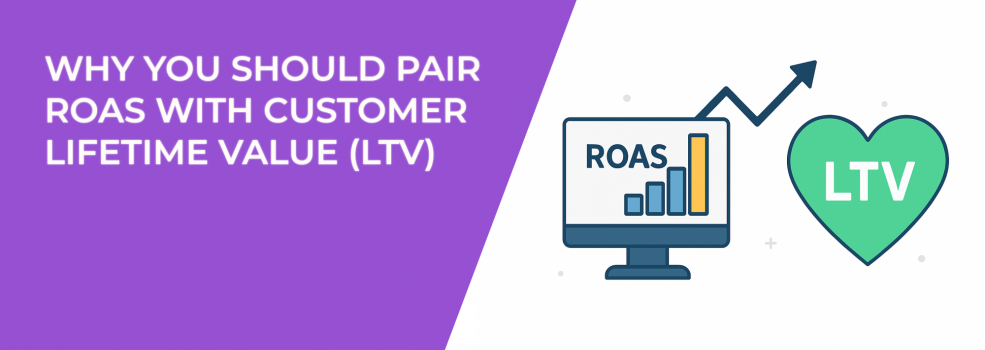When advertisers talk about success, one metric usually takes center stage: ROAS (Return on Ad Spend). It’s simple, clean, and easy to present in a report. Spend $1, make $4 back. Sounds perfect, right?
But marketing isn’t that straightforward. A campaign that looks like a winner today might actually hurt you long-term. That’s why pairing ROAS with Customer Lifetime Value (LTV) is a smarter way to measure results. Together, these two metrics reveal a more accurate picture of your ad performance and help you make better decisions about budget, targeting, and growth.
Why ROAS Alone Can Be Misleading
ROAS is great for showing the immediate efficiency of your ad spend. You can quickly see if a campaign is pulling in more revenue than it costs. The problem? ROAS only captures short-term results.
Imagine two campaigns:
-
Campaign A delivers a ROAS of 6x. Looks amazing. But the customers it brings in only buy once and never return.
-
Campaign B shows a ROAS of 3x. Not as shiny. But those customers keep coming back over the next year, doubling or tripling the revenue they generate.
Which one is actually more valuable?
ROAS alone won’t answer that. That’s where LTV changes the game.
Many advertisers focus too heavily on surface-level metrics. If you’ve ever struggled with campaigns that look good but don’t actually convert, our guide on How to Analyze Facebook Ad Performance Beyond CTR and CPC breaks down what numbers really matter.
How LTV Complements ROAS
Customer Lifetime Value (LTV) measures the total revenue you can expect from a customer during their entire relationship with your business. Instead of focusing only on the first purchase, it considers repeat sales, upsells, subscriptions, and referrals.
When you pair LTV with ROAS, you unlock insights that short-term metrics hide. You start to see:
-
Which campaigns bring in loyal, high-value customers.
-
How much you can afford to spend on acquiring new customers.
-
Whether scaling a campaign is sustainable over months, not just weeks.
It’s the difference between chasing quick wins and building long-term growth.
Practical Ways to Use ROAS and LTV Together
So, how do you actually use these two metrics in your daily marketing decisions? Think of ROAS as your short-term pulse check and LTV as your long-term compass. When you put them together, you stop making guesses and start making decisions that compound over time. Let’s break it down.
1. Set Smarter Acquisition Costs
Many advertisers put an artificial ceiling on how much they’re willing to pay to acquire a customer. The problem with that? You risk cutting off profitable growth.
Instead, let your LTV determine your Customer Acquisition Cost (CAC). Suppose your average LTV is $1,000. Spending $200 to acquire a customer doesn’t just make sense—it might actually be a bargain. Even if your ROAS looks modest at first, the long-term revenue proves the acquisition cost was justified.
A simple rule of thumb: your CAC should rarely exceed 20–30% of your average LTV. This ensures you leave enough margin for operating costs and profit while still allowing room for growth.
When you make decisions this way, you stop obsessing over the “cheap clicks” and start focusing on the “valuable customers.”
2. Identify High-Value Customer Segments
Not all customers are equal. Some will buy once and disappear. Others will come back again and again, driving far more value than their first purchase shows. The trick is figuring out which audience delivers the latter.
Start by breaking down your LTV by source or campaign. For example:
-
Customers acquired through a niche Facebook interest might spend 40% more over their lifetime than those acquired through broad targeting.
-
Buyers who enter through a high-value product bundle might stick around longer compared to those who start with discounted single items.
-
Customers from retargeting campaigns may show stronger repeat purchase behavior than those from prospecting ads.
By uncovering these patterns, you can double down on campaigns that bring in high-value customers instead of chasing volume that doesn’t last.
This is where platforms like LeadEnforce give you an edge — because when you can target audiences based on who they follow or which communities they’re part of, you’re more likely to connect with people who already show strong loyalty signals.
Want to go even deeper? Our step-by-step guide on How to Use Facebook Detailed Targeting to Reach Micro-Niche Audiences shows how to find segments that often deliver higher lifetime value.
3. Build More Sustainable Scaling Plans
Scaling ads based only on ROAS is like sprinting — you burn energy fast and run out of steam. When you add LTV to the mix, scaling becomes more like marathon training—you pace yourself, knowing the payoff is long-term.
Here’s an example: You notice a campaign is generating a 2.5x ROAS in the first 14 days. On paper, that might not look scalable. But when you check the cohort data, you see those same customers generate 5x in value over 6 months. Suddenly, scaling that campaign makes a lot of sense.
This kind of thinking protects you from pulling the plug too early on ads that actually deliver compounding returns. It also prevents over-investing in campaigns that look strong today but won’t hold up over time.
In short, ROAS tells you when to push the gas, but LTV tells you whether you have enough fuel in the tank to finish the race.
If you’re interested in proven tactics for scaling your ads, check out The Science of Scaling Facebook Ads Without Killing Performance.
4. Spot Hidden Underperformers
Every advertiser has campaigns that look “good enough” but quietly underperform when you take a closer look. ROAS alone can’t always expose them.
For example, imagine a campaign with a 4x ROAS. It seems healthy. But when you overlay LTV, you realize those customers rarely return and generate far less revenue over the next year. Compare that with another campaign running at 2.8x ROAS, but those customers have double the retention rate.
Which campaign would you scale? Which would you cut back?
This is the value of pairing ROAS and LTV: you start spotting the hidden underperformers that would otherwise eat up budget while delivering little long-term impact.
Sometimes campaigns that look strong on ROAS turn out to be silent budget drains. Our article on How to Spot Early Warning Signs of Underperforming Facebook Ads shows what to look for before you waste ad spend.
Making It Actionable
Metrics are great, but what matters is what you actually do with them.
Here’s a simple process you can start implementing right away:
-
Calculate your average LTV.
Don’t overcomplicate it. Use the formula:
Average Order Value × Purchase Frequency × Customer Lifespan.
Even if it’s a rough estimate, it gives you a baseline. -
Segment your customers.
Break LTV down by acquisition source, campaign, or product line. You’ll quickly see which groups are worth the most and which ones don’t deliver much past the first purchase. -
Compare against ROAS.
Put the two metrics side by side. Do campaigns with high ROAS also have high LTV? Or do some low-ROAS campaigns reveal surprising long-term value? These insights will reshape how you judge performance. -
Adjust budgets accordingly.
Shift spend toward campaigns that deliver both short-term returns and long-term value. Pull back on campaigns that look flashy in the short run but don’t actually create lasting customer relationships.
When you do this consistently, your ad strategy stops being reactive and becomes predictive. You’re not just chasing quick wins — you’re building a system that compounds value over time.
Why This Matters More Than Ever
Competition for attention is fierce. Advertising costs are rising. And customer loyalty isn’t guaranteed. Measuring performance with just ROAS is like reading one line of a book — you miss the whole story.
By combining ROAS with LTV, you’ll gain a clearer understanding of where your marketing dollars truly work. And you’ll put yourself in a stronger position to scale sustainably, without gambling on short-term wins that fade away.
The next time you’re looking at campaign performance, ask yourself: are you measuring success in days, or in years?

